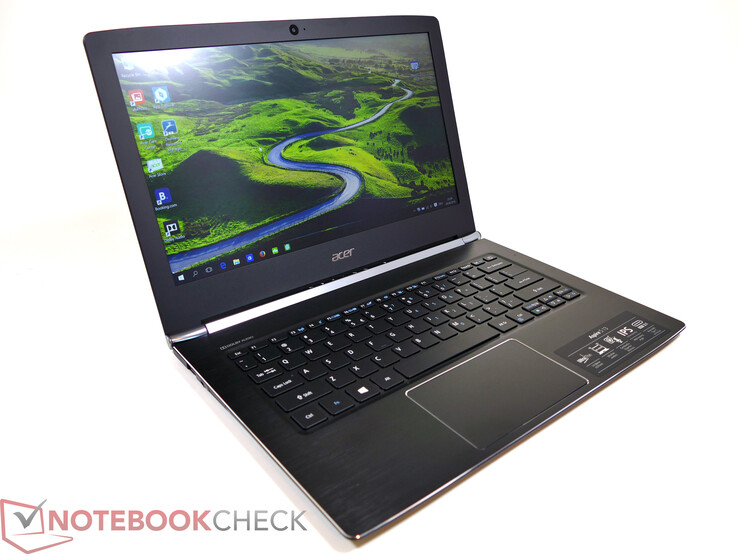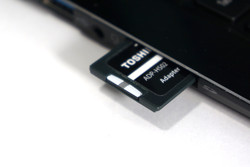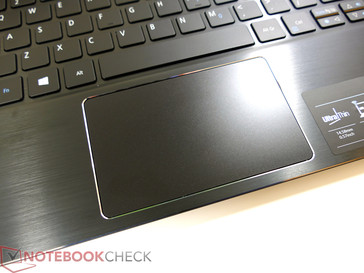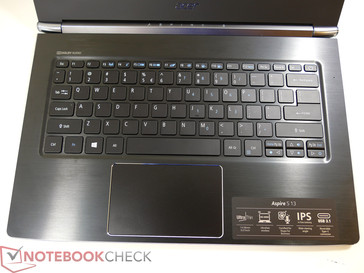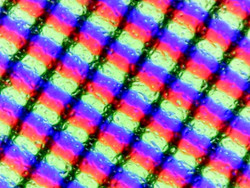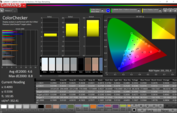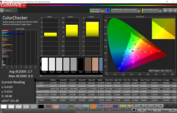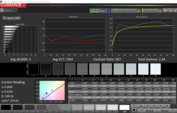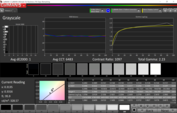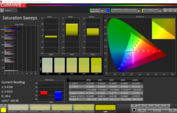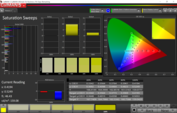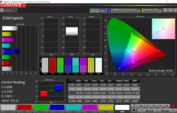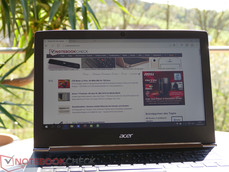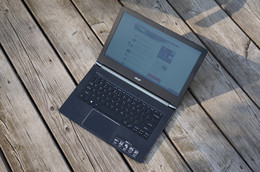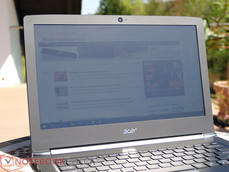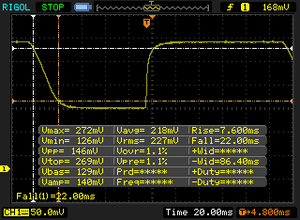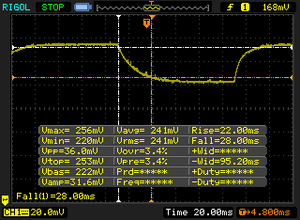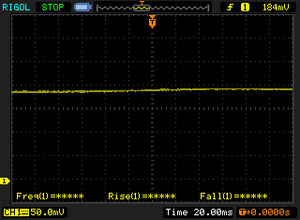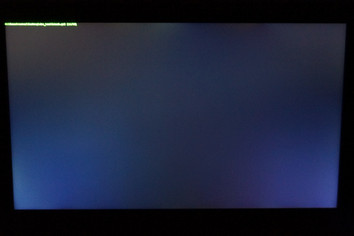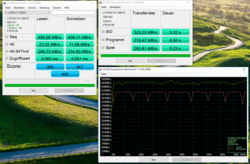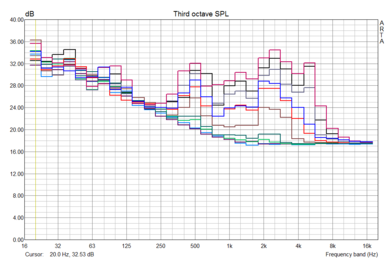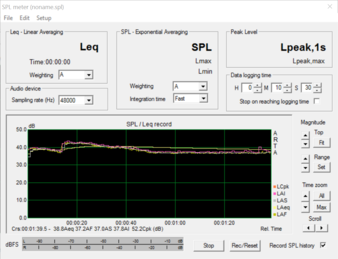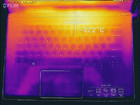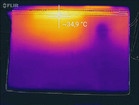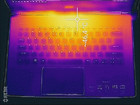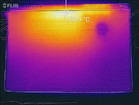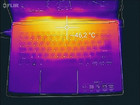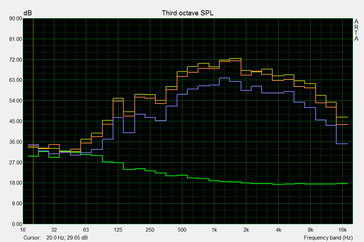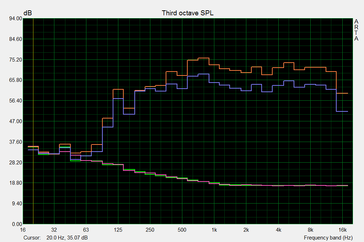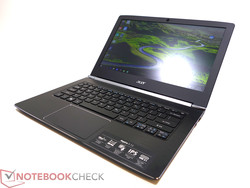Acer Aspire S 13 S5-371 Notebook Review

For the original German review, see here.
After the Aspire S7 and the cheap Aspire S3, Acer launches the next representative of the thin and light class. The Aspire S13 might be a happy medium between its two predecessors. While it uses high-end components, for example an Intel i7-6500U CPU, it resembles the Aspire S7 in display (Full HD, matte) and storage device (up to 512 GB SATA3 SSD). This creates an attractive, fast, and mobile computer for a price point of about 1000 Euros (~$1140). Does this sound familiar to you? For example the countless UX300 ZenBook models from Asus are in the exact same price range.
Updates / Changelog
- 05-10-2016 16:00 added information on the webcam and a video on the fan noise
- 05-04-2016 14:30 color space, rating, gaming benchmarks
- 05-03-2016 18:00 maintenance and upgrade possibilities explained and illustrated
- 05-03-2016 09:15 images/analysis outdoor use, audio analysis, SD card test, viewing angles
- 05-02-2016 17:00 Throttling analysis (performance, clock rates, and temperatures under CB15 and The Witcher 3 >1h)
- 05-01-2016 12:45 System noise and speakers; The Witcher 3 Benchmarks
- 05-01-2016 09:00 Battery Life under load, AS SSD and 3DMark 11 benchmarks
- 04-30-2016 23:44 PCMark 8 with analysis
- 04-30-2016 21:30 first publication
Case
Acer uses a beautiful mix of materials from aluminum (top side of the base unit) and magnesium composite (body) and plastic elements (display, lid). In view of the price point of 1000 Euros (~$1140), we had a throughout positive overall impression.
The lid features a groove-like texture, which feels soft to the touch and appears grippy. Moreover, the lid handles pressure well. Keyboard and touchpad are framed by a single aluminum part with smoothed edges, which give another accent to the look of the device. Also, it is quite insensitive to pressure. Abnormally forceful typing is required in order to depress the keyboard unit. The underside of the Aspire S13 behaves the same. It also features a matte finish and handles pressure and twisting well. Unfortunately, the top side of the base unit made from aluminum is a fingerprint magnet and quickly loses its visual appeal.
With a weight of 1.27 kg, the Acer Aspire S13 belongs to the lighter devices within our comparison group. Only the Dell XPS 13 (FHD) is slightly lighter, but it is also quite a bit different with its Infinity Edge display. The height of just above 14 mm is exemplary in comparison, even though many competitors are even a bit slimmer.
Upgrades & Maintenance
In order to get to the fan, battery, and M.2 SSD you first have to remove 10 Phillips screws and loosen the edge with a plastic spudger (to avoid damage) afterwards. Unfortunately, this is a cumbersome task, during which we ruined our tool. Once you have loosened the plastic clips, you can remove the underside and get to the internal components. It is praiseworthy that the battery is not glued but only connected with a plug and fixed with two screws. Even the fan can be directly reached for cleaning and the M.2 SSD can be replaced after removing another screw. The Qualcomm Wi-Fi module can be found in the upper-right corner. It is connected to two antennas and can also be replaced easily.
Connectivity
The interfaces are on the sides towards the rear. Each side houses a conventional USB-A 3.0 port. Thus, right-handed as well as left-handed people can connect a mouse without cable clutter. However, the built-in USB-C port is only Gen.1, i.e. USB 3.0 (5 GBit/s).
Communication
A special feature is the 802.11 n chip from Qualcomm, which is capable of MU-MIMO. At the beginning of the tests the WLAN connection was stable and the download rates were not slowed down. A 2 GB file was transferred from our slow WD MyCloud NAS at 60-70 MB/s (according to the Task Manager at above 600 MBit/s received traffic). However, we only achieved 250 Mbit/s (sending) and 320 Mbit/s (receiving) in a standard test with iperf (with our MU-MIMO capable Linksys EA8500 reference router). The same file from NAS also only reached 160-200 MBit/s according to the task manager after that.
| Networking | |
| iperf3 receive AX12 | |
| Apple MacBook Pro Retina 13 inch 2013-10 (Klaus I211) | |
| Lenovo ThinkPad T460s-20FA003GGE | |
| iperf3 transmit AX12 | |
| Apple MacBook Pro Retina 13 inch 2013-10 (Klaus I211) | |
| Lenovo ThinkPad T460s-20FA003GGE | |
| iperf Server (receive) TCP 1 m 512KB | |
| Lenovo ThinkPad T460s-20FA003GGE | |
| Dell Latitude 13 7370 | |
| Toshiba Tecra Z40-C-106 | |
| Dell Latitude 12 E5270 | |
| Lenovo ThinkPad 13-20GKS01100 | |
| iperf Client (transmit) TCP 1 m 512KB | |
| Lenovo ThinkPad T460s-20FA003GGE | |
| Dell Latitude 13 7370 | |
| Dell Latitude 12 E5270 | |
| Lenovo ThinkPad 13-20GKS01100 | |
| Toshiba Tecra Z40-C-106 | |
| iperf Server (receive) TCP 1 m | |
| Apple MacBook Pro Retina 13 inch 2013-10 | |
| Apple MacBook 12 (Early 2016) 1.1 GHz | |
| Acer Aspire S 13 S5-371-71QZ | |
| MSI GE72 965M Ti | |
| iperf Client (transmit) TCP 1 m | |
| Apple MacBook Pro Retina 13 inch 2013-10 (Hinum) | |
| Apple MacBook 12 (Early 2016) 1.1 GHz | |
| MSI GE72 965M Ti | |
| Acer Aspire S 13 S5-371-71QZ | |
| Chuwi Hi12 | |
Card reader
Unfortunately, the built-in full size SD-card reader has a serious disadvantage. Inserted cards stick out of the case considerably. Thus, you cannot leave them permanently in the device during mobile use. We have measured the performance with a relatively fast Toshiba Exceria Pro M401 micro SD card in an adapter. At about 80 MB/s, it almost achieves the specified maximum rate of 95 MB/s.
Input Devices
Keyboard
The back-lit keyboard delights with a comfortable, dampened stroke and allowed us smooth and fast typing with few errors from the start. We liked the layout, the key distance and the stroke. Only the cursor keys are a bit small. Note: We had a variant of the Aspire S 13 with QWERTY layout under review. QWERTZ keyboards will be incorporated in models sold by German dealers.
In the WPM (Words per Minute) test, the author achieved 84 WPM without long adaption. The test performed directly afterwards with a Cherry desktop keyboard (mechanical) resulted in 90 WPM. Typing errors were uniformly distributed. Overall, this is a very good result.
Touchpad
The Touchpad is comfortably big and features good gliding traits. Its lower 90% is clickable, though not absolutely even as a matter of principle. But, it works quite well for a "Windows touchpad". While it cannot keep up with the current MacBook Trackpad, it definitely belongs to the better ones in the Windows world.
Display
The built-in 13.3-inch widescreen (16:9) display features a resolution of 1920x1080 and is very bright with an average of 360 cd/m². Due to its matte surface, it is very suitable for use in bright environments. The brightness distribution of 87% is also very good. However, there is a slight backlight bleeding along the upper edge in our test model. The minimal brightness setting is not especially low at 32 cd/m² and probably a bit too high for enjoying reading in bed.
The color fidelity is only mediocre out-of-the-box. After calibration the average DeltaE is excellent, but a few higher values remain. We did not find PWM for brightness control. Typical of an IPS display, the response times were relatively high.
| |||||||||||||||||||||||||
Brightness Distribution: 87 %
Center on Battery: 375 cd/m²
Contrast: 962:1 (Black: 0.39 cd/m²)
ΔE ColorChecker Calman: 4.6 | ∀{0.5-29.43 Ø4.78}
ΔE Greyscale Calman: 4 | ∀{0.09-98 Ø5}
92.2% sRGB (Calman 2D)
88.7% sRGB (Argyll 1.6.3 3D)
57.9% AdobeRGB 1998 (Argyll 1.6.3 3D)
Gamma: 2.34
CCT: 7304 K
The high display brightness in combination with the matte surface makes for excellent legibility even in worst-case outdoor scenarios. As long as you avoid direct sunlight on the display, it is great to work with the Acer Aspire S13 outdoors.
Display Response Times
| ↔ Response Time Black to White | ||
|---|---|---|
| 29.6 ms ... rise ↗ and fall ↘ combined | ↗ 7.6 ms rise | |
| ↘ 22 ms fall | ||
| The screen shows relatively slow response rates in our tests and may be too slow for gamers. In comparison, all tested devices range from 0.1 (minimum) to 240 (maximum) ms. » 78 % of all devices are better. This means that the measured response time is worse than the average of all tested devices (20.2 ms). | ||
| ↔ Response Time 50% Grey to 80% Grey | ||
| 50 ms ... rise ↗ and fall ↘ combined | ↗ 22 ms rise | |
| ↘ 28 ms fall | ||
| The screen shows slow response rates in our tests and will be unsatisfactory for gamers. In comparison, all tested devices range from 0.165 (minimum) to 636 (maximum) ms. » 85 % of all devices are better. This means that the measured response time is worse than the average of all tested devices (31.6 ms). | ||
Screen Flickering / PWM (Pulse-Width Modulation)
| Screen flickering / PWM not detected | |||
In comparison: 53 % of all tested devices do not use PWM to dim the display. If PWM was detected, an average of 8111 (minimum: 5 - maximum: 343500) Hz was measured. | |||
In general, the viewing-angle stability is good. However, slight color shifts get visible at extreme angles. Certainly, it is still better than a TN panel and subjectively, colors and contrast remain stable when you move in front of the display in a normal way.
Performance
Our test model uses an Intel Core i7-6500U. In the first benchmarks, it shows an average to very good performance compared to other notebooks with i7-6500U. The same is true for the graphics unit. Apparently, the cooling is sufficient for good performance results from the dual-core CPU with integrated GPU.
Processor
We check the performance of the processor cores in Cinebench R15. The built-in Core i7-6500U achieves an average result in the single-core tests. The fastest i7-6500U is only 8% faster, while the slowest one only achieves 69% of the performance. In return, it is only 1% below the lead in the multi-core test. All things considered, this gives a very good performance.
After many Cinebench R15 Multi runs, the score of the Aspire S 13 is about 10% lower (292 versus 326 points). The clock rate remains stable between 2.6 and 2.7 GHz and the processor cores level off at 84 °C.
System Performance
In the system benchmark PCMark8 Home (3.0 accelerated), the S 13 is on par with the best notebooks with Core i7-6500Us. The Zenbook UX303UA (+5%), the Aspire R14 R5-471T (+3%), and the ThinkPad X1 Carbon (+3%) are only slightly faster. However, the Yoga 900, the XPS 13, and the Envy 13 are about 15% slower. The Full HD resolution can indeed lead to a performance gain compared to e.g. 4K notebooks.
Compared to all reviewed subnotebooks, the Aspire S13 performs excellently. The fastest device is the old EliteBook 820 G1, which, however, is only 10% faster. The average is significantly lower at 82%.
| PCMark 8 Home Score Accelerated v2 | 3386 points | |
| PCMark 8 Work Score Accelerated v2 | 4316 points | |
Help | ||
Storage Device
Our test model uses a 512 GB SSD from LiteOn as storage device. The LITEON CV1-8B512 is an M.2 2280 SATA SSD and specified with a maximum of 520/450 MB/s (read/write). With 502/418 MB/s, it achieves good results for a SATA SSD in CrystalDiskMark 3.0 and the AS SSD benchmark results also are nothing to sneeze at. Nevertheless, it is a bit unfortunate that the system does not use a faster NVMe SSD. However, it is questionable whether this would be noticeable in everyday tasks anyway.
| 3DMark 2001SE Standard | 27228 points | |
| 3DMark 03 Standard | 20522 points | |
| 3DMark 05 Standard | 15357 points | |
| 3DMark 06 Standard Score | 9959 points | |
| 3DMark Vantage P Result | 5884 points | |
| 3DMark 11 Performance | 1600 points | |
| 3DMark Fire Strike Score | 869 points | |
Help | ||
Gaming Performance
The integrated Intel HD Graphics 520 is only suitable for undemanding games. First of all, we tested the demanding The Witcher 3. It performs very well compared to other notebooks with integrated graphics but still remains unplayable at the bottom line. Moreover, it is positive that the performance is maintained on battery. The clock rate of the GPU fluctuates between 900 and 1000 MHz in The Witcher 3. The two CPU cores clock between 1600 and 3000 MHz. Unfortunately, we could not install a newer graphics driver from Intel during our review. According to the error message, the installed driver was modified by Acer and thus could not be upgraded.
Further gaming benchmarks are available in our GPU page to the Intel HD Graphics 520.
| low | med. | high | ultra | |
|---|---|---|---|---|
| BioShock Infinite (2013) | 57.9 | 30.8 | 25.5 | 7.6 |
| GTA V (2015) | 34 | 27.1 | 7 | |
| The Witcher 3 (2015) | 14.1 | |||
| World of Warships (2015) | 71 | 46.1 | 22.3 | 16.1 |
| Just Cause 3 (2015) | 0 game wont start | |||
| The Division (2016) | 21.1 |
| 3DMark 2001SE Standard | 27228 points | |
| 3DMark 03 Standard | 20522 points | |
| 3DMark 05 Standard | 15357 points | |
| 3DMark 06 Standard Score | 9959 points | |
| 3DMark Vantage P Result | 5884 points | |
| 3DMark 11 Performance | 1600 points | |
| 3DMark Fire Strike Score | 869 points | |
Help | ||
Emissions
System Noise
According to our first observations, the cooling system is a mixed bag. The measured system noise is not at all excessive. The fan usually remains off without load and the device is silent. Unfortunately, the small fan quickly starts running at minimal load. During our test, this already happened when opening websites or installing programs. Although the measured system noise remains low at mostly 31.3 dB (rarely 33 dB), the noise characteristic is relatively unpleasant due to a high frequency and is very audible in quiet environments. Moreover, the fan speed changes permanently, which makes it even more discernible.
Under load, the fan mostly levels off at 36.9 dB. However, there also are higher peaks. For example, the device got as loud as 42 dB for a short time during the first 3DMark06 run on a cold device. In addition, it frequently speeds up after programs have already been closed as if it would want to blow the rest of the heat out of the cooling system. Since the frequency is also unpleasantly high at higher rotation speeds, sensitive users might feel disturbed in quiet environments. If you are going to use the laptop in a normally loud office, the ambient noise will certainly drown out the fan.
In view of the observed uncritical temperatures inside, it might be possible to moderate the too active fan under low load with a software update. Acer is currently working on such a BIOS upgrade. If possible, we will recheck the Aspire afterwards.
Noise level
| Idle |
| 31.2 / 31.2 / 31.5 dB(A) |
| Load |
| 35.7 / 35.8 dB(A) |
 | ||
30 dB silent 40 dB(A) audible 50 dB(A) loud |
||
min: | ||
Temperature
Apparently, Acer deliberately uses the thin aluminum case for conducting heat away. While the temperatures are still tolerable without load, the surface temperatures got very hot during our extreme load scenario with Furmark and Prime95. On the underside we observed a hot spot of 53 °C, which is the maximum we measured in our laboratory stress test. Unfortunately, these values are not too far from reality, since the notebook gets similarly hot during The Witcher 3 (underside: 52 °C); see infrared image below.
However, the important palm rests always remain pleasantly cool. Thus it's better to use the laptop on the desk than on the sofa when load is applied.
The internal temperatures do not get too hot under load. The CPU reaches a maximum of 76 °C and the GPU of 82 °C during The Witcher 3. After multiple successive runs of Cinebench R15 multi-core, the processor cores reach 84 °C. This also is not critical and 16 °C lower than the limit.
(+) The maximum temperature on the upper side is 38.5 °C / 101 F, compared to the average of 35.9 °C / 97 F, ranging from 21.4 to 59 °C for the class Subnotebook.
(-) The bottom heats up to a maximum of 47.7 °C / 118 F, compared to the average of 39.3 °C / 103 F
(+) In idle usage, the average temperature for the upper side is 25.8 °C / 78 F, compared to the device average of 30.8 °C / 87 F.
(+) The palmrests and touchpad are cooler than skin temperature with a maximum of 26.9 °C / 80.4 F and are therefore cool to the touch.
(±) The average temperature of the palmrest area of similar devices was 28.2 °C / 82.8 F (+1.3 °C / 2.4 F).
Speakers
In a first impression, the speakers play loud and clear. However, the sound lacks basses. It becomes apparent in the direct comparison to the frequency diagram of the new Apple MacBook 12, which generates an excellent sound in view of its size, that the Aspire S 13 especially shows weaknesses in low frequencies as well as high frequencies. The MB 12 is louder in both ranges and shows a more linear frequency curve overall.
Energy Management
Power Consumption
The Acer Aspire is not a power eater when in standby or off. Measured rates of 0.2 and 0.3 Watt, respectively, are pleasantly low. It becomes apparent under load that the device does not require more energy in our extreme load scenario than during 3DMark06. The small power adapter, which remains cool, is rated at 45 Watt and should not be a limiting factor here. However, CPU and GPU clocks are reduced according to HWInfo. We did not have the final power adapter available for the measurements above. Standby values as well as temperatures of the power adapter could be different with it.
| Off / Standby | |
| Idle | |
| Load |
|
Key:
min: | |
Battery Life
With 7.5 hours (452 minutes) in our Wi-Fi battery test (opens web pages via script at 150 cd/m² brightness), the Acer Aspire S 13 is just above average (the reviewed subnotebooks of the last 24 months achieved 422 minutes on average). The Toshiba Satellite Z30-B-100 leads with an impressive 12 hours. The Zenbook UX305UA-FC040T with the same CPU/GPU combination accomplished 561 minutes (above 9 hours) and is the best 6500U device.
However, the minimal measured battery life (Battery Eater Classic = gaming load at maximum brightness), is definitely below average. The relatively short battery life of 1.5 hours is certainly due to the high maximum brightness. For example, the demanding The Witcher 3 ran for two hours and five minutes at 150 cd/m²; unfortunately only at 14 - 16 fps, but without performance loss compared to mains operation.
Pros
Cons
Verdict
Our first impression of the Acer Aspire S 13 was very positive and this was primarily confirmed through the rest of the test. We liked the case, the input devices and the display. Although the color fidelity should be better out-of-the-box (very good results after calibration), the matte surface combined with a high maximum brightness is a big pro.
We did not like the fan behavior of our early test model that much, which shows an unpleasant frequency. We have to wait for a BIOS update here, since an active fan is not necessary under low load in view of the temperatures. According to Acer, they are already working on an update in order to fix this problem. This could significantly improve our system noise rating and the notebook's total rating might increase by one percent point.
Fast system, bright and matte IPS display as well as good battery life in realistic scenarios: Acer created a well-made bundle for mobile users with the Aspire S 13.
Further pros of the Aspire S 13 are its good performance and battery life of above 7 hours in real-world scenarios. Moreover, the input devices were convincing in our test.
The Asus Zenbooks, including the UX305CA with passive cooling or the similarly equipped UX303UA, are quite similarly positioned as the Acer Aspire S13. Acer's Aspire R13 R7-372T is an interesting alternative from the 2-in-1 range. Currently, the Dell XPS 13 is very successful in the 13-inch range and variants with i5 CPU and FHD display are similarly priced.




